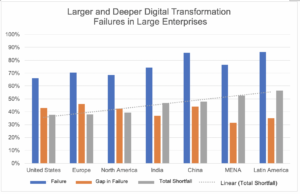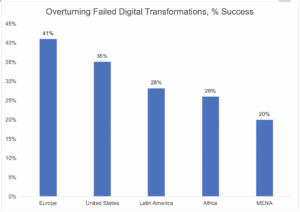This summary is provided as part of our Dialogue on Digital Transformation series.
In addition to acting as senior advisor to Fortino Capital, a VC firm specialised in B2B Saas, and a venture partner at Antler, Dr. Jacques Bughin is currently teaching business strategy at Solvay Business School and sits on the Portulans Board of Advisors. Dr. Bughin was a director in McKinsey’s Brussels office and supported clients in their Media and Entertainment, Corporate Finance, and Strategy Practices, in addition to co-leading the Digital Economy Initiative. He also acted as director of the McKinsey Global Institute (MGI), the firm’s business and economics research arm. He worked for McKinsey for 28 years. Dr. Bughin received a PhD in economics, operations research, and strategy from Université Catholique de Louvain in Belgium.
In recent years, much has been said about the global digital divide which has emerged between those countries with strong, inclusive digital infrastructure and countries on the fringe. Make no mistake: the fact that the digital divide still exists is unacceptable, particularly given that broad gaps in access were identified as long as a quarter-century ago. Still, by 2020, due in good part to the large push by international organizations and NGOs to fund and nurture the ICT revolution in developing countries, we can see significant, if slow, progress towards digital inclusion.
The digital divide is, however, a “moving target”. Firstly, the digital divide, in its original conception, was more concerned with the availability of digital infrastructure. But this infrastructure requires constant upgrades as we move along multiple generations of access, from 2G to 5G, and as we move from onsite to more versatile cloud and edge solutions. Second, there is still a large difference in the performance of digital infrastructure. As younger, and more skilled populations move to cities, the economics of “rich density” favor the deployment of shorter last mile infrastructure, with higher associated access performance, in contrast to rural areas where limited population density makes the layout of dense infrastructure too costly. This urban-rural digital divide is much more prevalent in developing countries, as broadband affordability is generally low.
Third, an important division is the difference between the abilities and resources required to use digital infrastructure properly. In recent years, the application and platform aspects of digitization have exploded in popularity, resulting in a new type of digital divide. Namely, there is a disjuncture between population and Internet use and access, particularly in developing countries, which do not have their “fair share” in digitization. To take a striking example, Sub-Saharan Africa hosts five of the most populated countries in the world: yet none of these five countries are ranked in the Top 50 digital ecosystems in the world, according to rankings by Blink.
Fourth, an important digital divide is emerging in the traditional corporate world. This has been the subject of research in recent months, as a result of working sessions with the ITC and the UN, and brainstorming sessions with colleagues at the Portulans Institute. Complementing these efforts, research teams have leveraged some recent work done looking at key predictors of [digital] transformation success within firms. This research focuses on large firms (with at least USD 1 billion in revenue). Our findings suggest several new dimensions of and insights about the digital divide.
Not engaging in digital transformation, particularly for large incumbents, involves the risk of major disruption through product cannibalization, service obsolescence or exacerbated competition. Trillions of dollars have been spent on digital transformation across sectors, with an estimated USD 2.3 trillion to be spent by 2023. Today, there is no longer a clear-cut digital divide between companies that have and have not launched digital transformation. In fact, a larger portion of major incumbents in countries in the Asia Pacific (Taiwan, South Korea and Hong Kong), Europe or in the MENA region claim to have launched their transformations than large enterprises in North America. In Latin America, 80 to 85 percent of large firms are in the process of an enterprise-wide digital transformation, launched within the last three years. Our research suggests there are no material differences among the digital transformation launch performance in regional blocks.

The digital divide that is emerging is thus not that much in the speed of launching transformation, but rather in the ability to make it a success or failure: when there is success, can it be scaled?
This won’t come as a surprise, but only one-third of digital transformations are successful. The order of magnitude of this failure is rather substantial – we estimate that the associated shortfall to objectives is typically more than 50% of the estimated shortfalls in the original transformation plan.

Here, we see the emergence of a new digital divide, as Western Europe and the US witness lower failure rates in the transformation of their organizations. The divergence is further compounded by how bad the failure rate is overall. Combining a lower success rate and a higher performance gap when failing leads to a significant divide, as the two effects are multiplicative against aspiring countries. We found that the gap is just below 40 percent in the US and Europe as a whole, but it reaches 60 percent in Latin America, for example.
If digital transformation success remains evasive, the option remains: relaunching a failing programme. The good news is that this second chance offered enterprises may double the success rate of digital transformation. Still, developing countries face a divide, as our data suggests they are less able to learn from their failure.

There is also a large scaling potential for companies headquartered in developed regions than those headquartered in developing countries. For example, the portion of companies scaling their digital revenue (as a cut off, our study considers 20 percent revenue is digital) is twice in Europe and North America compared to Africa, among large incumbent companies.

In summary, higher and deeper failure rates, as well as lower scaling for developing countries than developed countries, suggests that digital transformation performance is twice as visible in Europe and North America than in other developing regions. A large part of a successful digital revolution is the successful economic transformation of our industrial structures to structures that represent the knowledge economy of tomorrow. We must concede that a digital divide is present, and has the capacity to transform countries.



